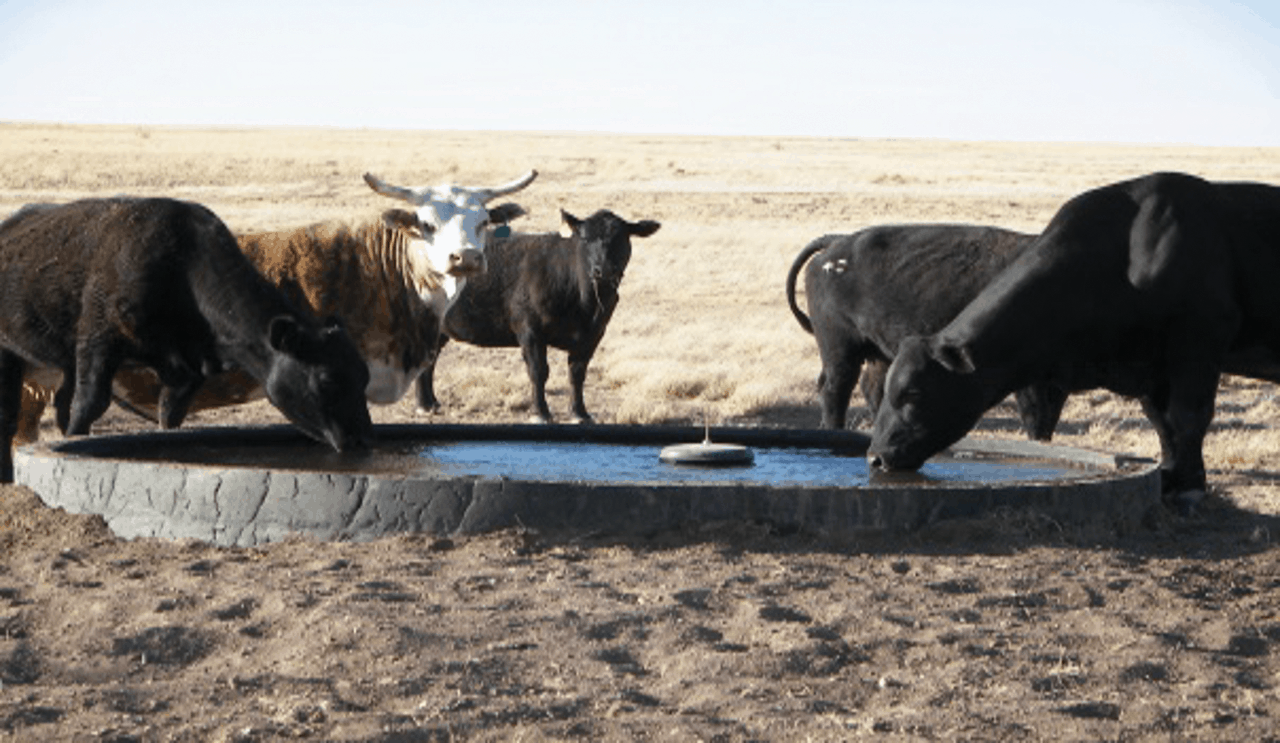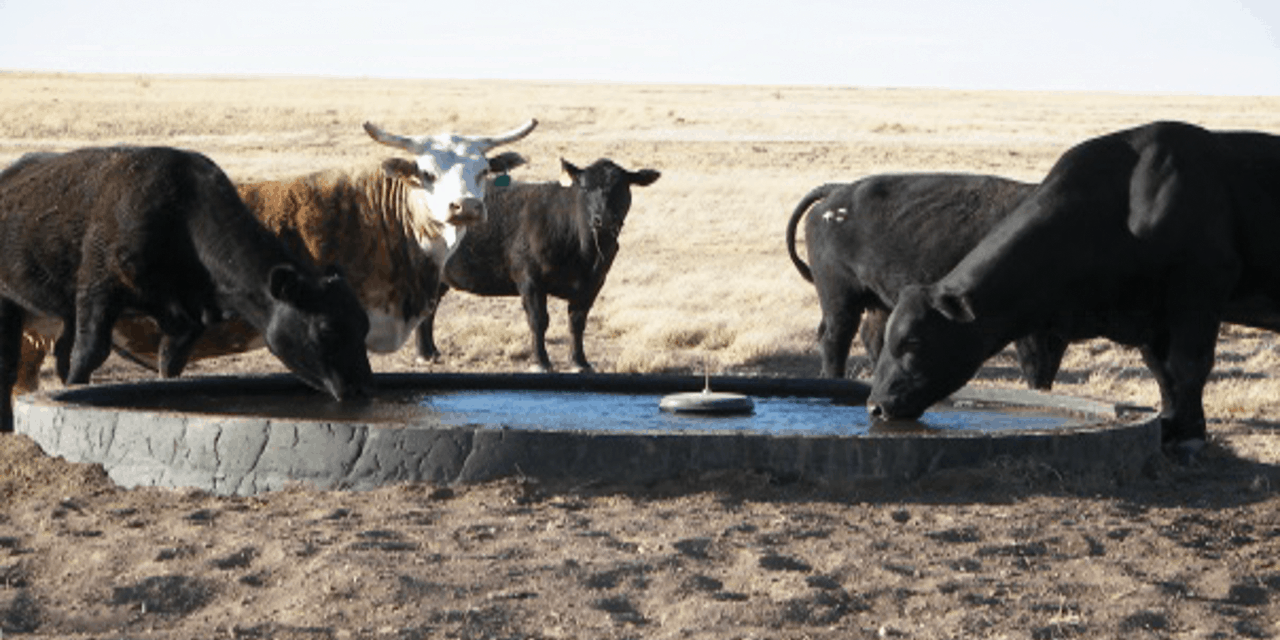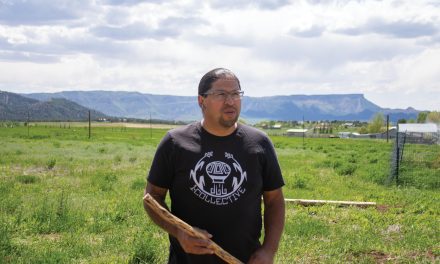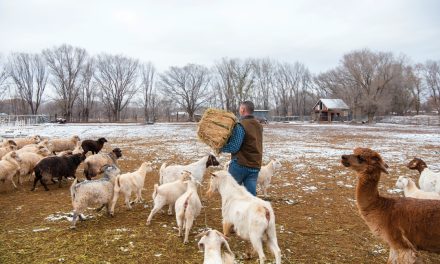Mike Lisk Helps Ranchers Redistribute their Most Valuable Resource
By Nora Hickey

Cattle at a Remote Well drinker. The drinkers conserve groundwater, pumping only what is needed. Photo courtesy of Mike Lisk.
The history of New Mexico is one inextricably linked with water—or the lack of it. Rain comes rarely, but when it does, it often arrives as a welcome deluge to a choked land. New Mexicans are familiar with the word drought and the body’s visceral reactions to it. Who here hasn’t felt the dry heat of a sun-bleached day?
Those who dwell in the city are no strangers to water restrictions on their allotment for yards and gardens. But what about those who must labor in fields afar, the men and women who keep the agricultural mechanisms of the state turning? For rural ranchers of New Mexico, the problem of water can be a matter of life or death. That’s why the story of one man’s relationship to water is so significant.
Mike Lisk came to Lincoln County after a thirty-year career as an engineer in Arizona. “My wife and I moved to New Mexico to retire and we bought a ranch,” Lisk explains. Lisk’s plan to spend his days leisurely on the land was soon thwarted by the issue that occupies many New Mexican ranchers in the end—water. Or rather, the poor distribution of it. He explains, “There was feed in a lot of areas on our ranch, but it was too far for the cattle to walk to. The areas that were concentrated by water were overgrazed.” Once Lisk started spreading the sources of water more evenly on their land, he saw immediate
effects: less overgrazing and fatter, more content cattle.
Lisk was curious about other ranchers’ experiences and started to visit with others to see if they suffered from the same water distribution issues. “We saw a tremendous waste of water with the current system. Much of the water is lost to evaporation,” Lisk says. The windmill system, found on many rural ranches throughout New Mexico, works by, of course, the wind, which causes the arms to move and water to be pumped from a source into open containers for animals to drink from. But the issue with the mechanism, which has punctuated open land for generations, is the loss of water that comes with the inability to stop its flow. “When the water gets pumped out of the ground and the tank is full, it just overflows,” Lisk explains. “No matter the percentage of rainfall in New Mexico, it doesn’t matter—you’re going to lose about a third of the water with the windmills.”
To address that water waste, Lisk created a solar-powered monitoring and filling system for cattle and wildlife drinkers. “Our systems are fully automated and solar-powered. They use pressure differentiations to sense water levels in tanks far, far away. You can look and see the percentage of water in the tank—so you know if it’s eighty percent or however much,” he says. Through Remote Well Solutions LLC, his startup company based in Cloudcroft, Lisk hopes to make ranching more successful and sustainable.

Top left: Many Navajo livestock producers must haul water to support the needs of the livestock—an expensive and time-consuming process. Top right: The majority of dirt tanks are dependent on rain, and as they silt in and dry up, they can be deadly traps for livestock and wildlife.
The bottom four photos show the components of the Well Watchmen system by Remote Well Solutions. Left middle: Pumping plant. Left bottom: Drinker. Right middle: Solar pumping plant. Bottom right: The controller automatically turns a solar pump on and off to maintain water levels without overfilling. Photos courtesy of Mike Lisk.
With remote monitoring, the need to drive out and check on water levels is rendered needless. “We talk about carbon footprints, and with so many of these ranchers, there’s a two-hour trip on a rough road, hauling water from the town to the cattle,” Lisk says. And cattle won’t be the only beneficiaries of Lisk’s solution; thirsty wildlife will gain as well, and the prairie grasses that the animals eat will have more time and space for renewal and growth.
As Lisk took his solar-powered monitoring system to different agricultural and ranching gatherings, a group that showed particular interest was the Navajo Nation. For the Navajo, with land that spans nearly thirty thousand square miles, reaching into Arizona, New Mexico, and Utah, ranching has been a part of life for many years. With such large tracts of rural land, Navajo tribal farms in particular have struggled with delivering water adequately to their animals.
“We have several tribal ranches [operating separately from livestock operations] that are practically off the grid. There’s no power for our watering system out there so we rely on windmills, which we continue to have ongoing maintenance issues with, and on natural springs,” explains Ferdinand Notah, project program specialist of the Navajo Department of Agriculture. But, with Remote Well Solutions, these issues can be mediated. “If we are able to extend the water lines beyond the well site, the animals will eat where the grasses are taller, gain more weight, travel less distance, and then that energy goes into weight gain,” Notah says.
That weight gain translates into more income for the ranchers, and a possibility to have more cattle on a single ranch. “Through increasing capacity, we will in turn increase revenue back to the Navajo Nation,” Notah says. “Hopefully we will elevate ranching into a more sustainable, resilient economy—basically using science and practical measures and trying to make agriculture a major contributor to our economy.” In addition to improving cattle health and numbers, Remote Well Solutions will also provide a variety of jobs. “We see on these rural lands that when people get educated, there’s no opportunities there, so they leave,” Lisk explains. “We’re excited to offer training and a good paying job.” Lisk and the Navajo Nation will start installation in April.
To hear Notah speak of it is to appreciate the magnitude of the potential ranching can provide. “That is our livelihood. Basically, we want Navajo to grow Navajo, eat Navajo, and we can get away from what we know as a food desert. We can reverse that heavy reliance on the big supermarket chains on the border towns. It’s a process of nation building.”
Even as the weather grows more unpredictable, changing at a moment’s notice from a thunderous storm to a soundless, bleached sky, Lisk’s creation will make ranchers’ turbulent lives steadier.
Edible celebrates New Mexico's food culture, season by season. We believe that knowing where our food comes from is a powerful thing. With our high-quality, aesthetically pleasing and informative publication, we inspire readers to support and celebrate the growers, producers, chefs, beverage and food artisans, and other food professionals in our community.












